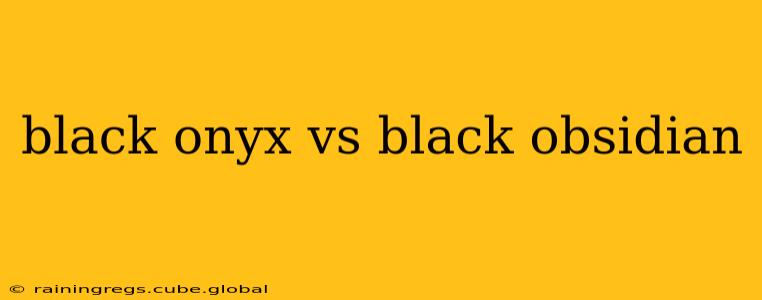Black onyx and black obsidian are both dark, captivating gemstones often confused for one another. While visually similar at first glance, they possess distinct differences in their formation, properties, and even spiritual associations. This comprehensive guide will delve into the key distinctions between black onyx and black obsidian, helping you confidently identify and appreciate each stone's unique beauty.
What is Black Onyx?
Black onyx is a variety of chalcedony, a microcrystalline form of quartz. Its intense black color is due to trace amounts of impurities within its structure. It's formed through a process of slow, gradual deposition of silica in cavities within the earth. This results in a dense, relatively hard stone with a waxy luster. Unlike obsidian, onyx is opaque, meaning light cannot pass through it.
Key Characteristics of Black Onyx:
- Formation: Microcrystalline quartz, a sedimentary rock.
- Hardness: 6.5-7 on the Mohs Hardness Scale (relatively durable).
- Luster: Waxy to vitreous (glassy).
- Transparency: Opaque.
- Color: Deep, even black (though variations exist).
- Treatments: Some black onyx may be treated to enhance its color or clarity.
What is Black Obsidian?
Black obsidian, in contrast, is a volcanic glass. It's formed when molten lava cools rapidly, leaving little to no time for crystal structures to form. This rapid cooling results in a smooth, glassy texture. The intense black color is largely due to its minimal inclusion of other minerals. Its amorphous structure makes it distinctly different from crystalline stones like onyx.
Key Characteristics of Black Obsidian:
- Formation: Volcanic glass, an igneous rock.
- Hardness: 5-5.5 on the Mohs Hardness Scale (less durable than onyx).
- Luster: Vitreous (glassy).
- Transparency: Can range from opaque to translucent in thin sections, though usually opaque.
- Color: Usually deep black, but can exhibit other colors depending on mineral inclusions.
- Treatments: Generally requires no treatments.
Black Onyx vs. Black Obsidian: A Comparison Table
| Feature | Black Onyx | Black Obsidian |
|---|---|---|
| Formation | Sedimentary (microcrystalline quartz) | Igneous (volcanic glass) |
| Hardness | 6.5-7 Mohs | 5-5.5 Mohs |
| Luster | Waxy to vitreous | Vitreous |
| Transparency | Opaque | Usually opaque, sometimes translucent |
| Structure | Crystalline | Amorphous |
| Durability | More durable | Less durable |
| Formation Process | Slow deposition of silica | Rapid cooling of lava |
How to Tell Black Onyx and Black Obsidian Apart
The most reliable way to differentiate between the two is through a combination of visual inspection and a hardness test.
- Visual Inspection: While both are black, onyx often has a slightly more subtle, less intense black than obsidian. Obsidian can sometimes have a more glassy, almost reflective surface. Close examination might reveal subtle banding or patterns in onyx that are less common in obsidian.
- Hardness Test: A simple scratch test (using a steel object) can be helpful, although not definitive. Onyx, being harder, will resist scratching better than obsidian. However, this method needs to be approached cautiously to avoid damaging the stones. A professional gemologist can provide the most accurate identification.
What are the metaphysical properties attributed to Black Onyx and Black Obsidian?
Many believe that gemstones possess metaphysical properties. While scientific evidence is lacking, these beliefs are deeply rooted in various cultures and traditions.
Metaphysical Properties Attributed to Black Onyx:
Black onyx is often associated with protection, grounding, and strength. Some believe it can help alleviate stress, promote self-control, and boost self-confidence.
Metaphysical Properties Attributed to Black Obsidian:
Black obsidian is commonly associated with protection from negativity, promoting introspection, and facilitating transformation. Some believe it can help to release emotional blockages and encourage clarity.
Conclusion
Black onyx and black obsidian, though visually similar, are distinct gemstones with unique geological origins and properties. Understanding their differences allows for a greater appreciation of their individual beauty and purported metaphysical attributes. Remember that identifying gemstones accurately requires careful observation and, if in doubt, professional consultation.
